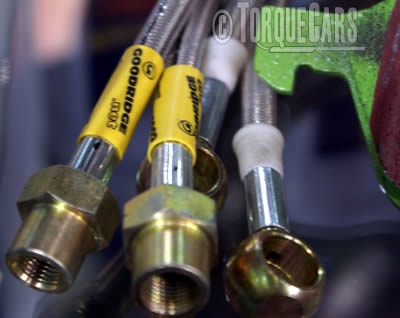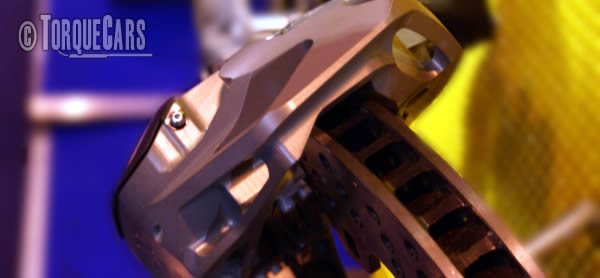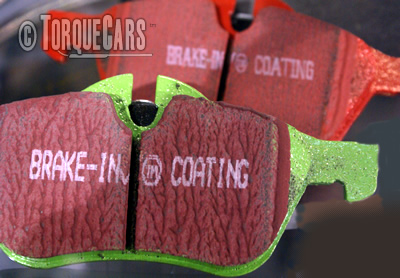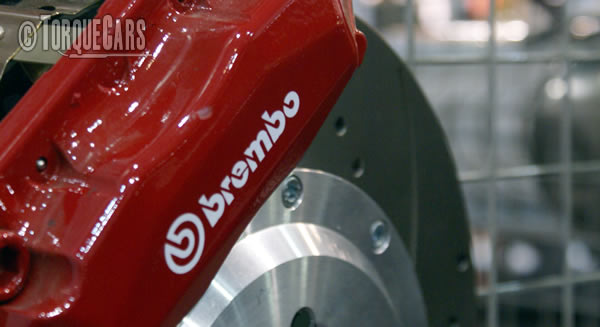Uprating brakes is an essential modification.
"There's always time for a brake!"

Brakes – part of going fast requires that one is able to stop as fast.
The brake works with a friction pad, which is pressed against a Disc – the friction converts the momentum of the car into heat which is then dissipated over the brake disc slowing up the car.
Heat is a big problem with heavy braking and a racecar must be prepped to cope with the high heat demands placed on the braking system.
The braking force goes from the pedal into a magic box called a servo, which uses engine power to amplify the pressure of your foot decreasing the effort you need to expend.
The pressure is transferred to the friction pads by means of liquid (brake fluid) inside a tube. At the brake pad end, which is subject to high temperatures, the fluid itself can get very hot.
The benefits of using a liquid, which cannot be easily pressurised, means that the effect of braking passes along the tube (brake pipes) almost instantly. A cable would stretch a little and needs constant adjusting – most handbrakes use a cable system so you are aware how inefficient the cable brake system is also cables are more susceptible to the effects of heat and stretching.
The problem with brake fluids are that they are hygroscopic (they draw in water particles) which reduce the effectiveness of the transference process also at high temperatures they can boil – bubbles of air in the brake fluid create a spongy effect at least or at worst can completely prevent the brake from having any effect. (See the article on Brake Fade for more details of this phenomenon and how it can be avoided.)

The heat is dissipated from the pad by the discs – a vented disc has a central channel which increases the surface to air ratio of the disc and created better and faster cooling.
Drilled discs also increase the air ratio and along with grooves help to prevent a gas build up between the pad and the disc and keep the pads ‘clean and sharp’.
Bigger discs = better cooling but bigger discs may require a different style of alloy wheel.

Brake pad selection.
The pads though are an essential part – the higher the friction the better.
Racing pads are specially constructed from a high friction compound which works at much higher temperatures.
A true racing pad will start working effectively only when it gets hot so this renders race spec pads useless for the road where braking most often happens on cold pads.
TorqueCars have found that fast road pads such as those supplied by Pagid and Black Diamond are a very good compromise and some makes of performance pads have the added benefit of producing nearly zero brake dust and even last longer than the standards pads I was using – although driving style will effect the wear on the pad and on your discs.
ABS helps to prevent lockups under heavy braking and allows you to steer the car but steering will reduce the braking efficiency as the ABS cuts in more. ABS on gravel and snow can actually be a problem as the brakes are cut due to loss of traction whereas if the wheels where slowed a little the car could stop more quickly.
Rally cars have a custom ABS setup which is quite different to standard road cars and maintains control and braking efficiency on gravel surfaces. If you are not a competent mechanic Torquecars recommend that you leave brake work to the specialist as a failure would result in a certain accident.

Brake upgrade kits.
There is much that can be done to upgrade the cars braking system. Key areas for attention are fitting bigger discs. As a larger disc will have a bigger friction area and be able to dissipate more heat you will benefit immediately. You will also notice you have more feel and it is easier to detect the point of lock up with a large disc conversion kit. Taking a standard family car with relatively small discs, as an example, an easy and cheap route would be to visit the breakers yard and get brake disks and servos from a performance model from the same family. For example a basic 1.1L car will usually upgrade to the 1.8 GTi brakes (you may need to upgrade the wheels at the same time). And often small cars share similar part specifications to the larger executive counterparts so a little research and chatting with our forum members will point you in the right direction.
Brake calipers and pistons next come in for attention. More pistons equal a greater clamping force and allow the use of much larger pads. Torquecars see little point of adding more pistons to a standard size disc as the heat dissipation ability of the disc will be impaired by the larger pads used. When upgrading the discs you should also look into increasing the pad, caliper and number of pistons for best effect.
General maintenance & care.
When driving through floods apply the brakes briefly to dissipate the water and grease that gets on them and this will dramatically improve your chances of stopping in an emergency situation.
Once a year or if you notice the brakes losing their effectiveness you should rough up the disc surface with abrasive steel wool or similar. This will brake the glaze and help the pad to bite the disc more effectively. You should always check your pads for wear and if you are preparing for a track day Torquecars recommend fitting new pads as these will take a lot of abuse. Check the brake discs for wear by measuring the diameter and ensure that a wear ridge is not appearing on the outside. Thin brake discs can warp or under heat stress can brake causing a wheel lockup so it really is a false economy to run with worn discs.
Brake fluid should also be frequently checked and changed annually to bi-annually depending on your driving style and the recommended service interval for your car.B rake fluid should be checked ideally by a specialist for its boiling point which gives an idea of its degradation. Synthetic (dot5) brake fluids are not hygroscopic and have extremely high boiling points. Stainless steel braided hoses prevent any flexing and therefore loss of pressure at the pad end, they also look nicer and theoretically last longer too – get a full set and do front and back at the same time.
Please join us in our friendly forum to catch up with the latest trends in brake upgrades, car tuning and car modification for your car model.
If you liked this page please share it with your friends, drop a link to it in your favourite forum or use the bookmarking options to save it to your social media profile.
Check out TorqueCars new YouTube channel, and see their awesome new content...
Feedback
Please use our forums if you wish to ask a tuning question, and please note we do not sell parts or services, we are just an online magazine.
Help us improve, leave a suggestion or tip
